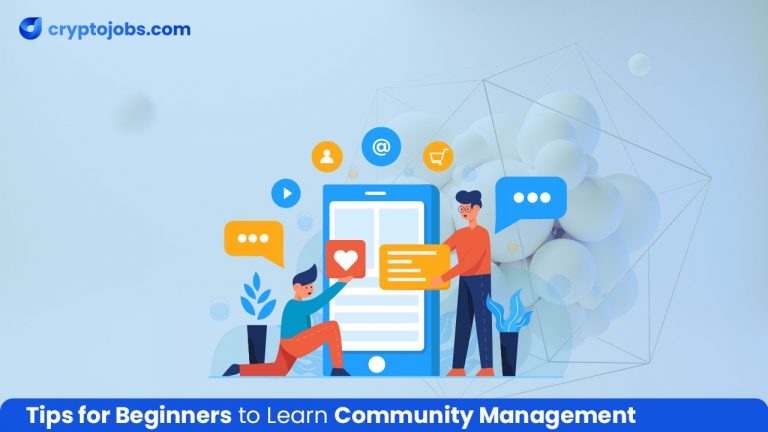
Tips for Beginners to Learn Community Management
- cryptojobs.com
- January 31, 2024
- All Posts, Career Guide
- Community Manager
- 0 Comments
Community management serves as the core of every business. They cultivate a sense of belonging and loyalty between the business and its consumers. Engaging in communication driven by interactions and fostering a familial connection are key responsibilities for those interested in community management jobs.
However, the role of the community manager does not just end there. It requires learning more about how you can become a successful community manager. As a beginner in the field, you may reach some roadblocks and issues that may stump you, but with proper research and dedication, you can become a vital part of the community management team at your new crypto company.
Here are some tips that will help you settle into your new role at your new crypto job and excel at it, too!
What is Community Management?
Community management is about engaging with a company’s carefully curated community through daily communication in the form of discussions and conversations, answering queries, and welcoming new members to various platforms.
If you have ever managed a community page on Facebook or a server on Discord, the community manager’s role is almost the same, but on a grander scale with a few exceptions. While you might have experience casually managing communities based on hobbies, a professional community management role has guidelines and rules that you have to follow.
When working as a community manager for an organization, you are required to seek permission for every step you take and even interaction you have. You are the face of the brand and have to represent the company in that community. Hence, no action can be taken without prior approval or proper planning.
Different Types of Community Management
No two community management jobs have the same responsibility. There are seven different types of community management roles that you can choose from, and they are best understood using the SPACE model.
S: Support Community Management
The primary form of community management revolves around customer support and success. This can manifest in various ways, such as a forum, an FAQ document, or a dedicated community website. Utilizing a forum, often structured as a question-and-answer platform, provides an excellent avenue for engaging with the community, addressing queries, and fostering interaction among members. Additionally, it serves as a platform to gather valuable customer feedback.
In the forum, sharing FAQ documents enables community members to find quick solutions to commonly raised questions independently. For a more organized approach, a customer success platform or software can be employed to create a branded website or landing page. This dedicated space allows for focused support, enabling users to help themselves and each other, communicate with the company’s teams, access essential resources, and consult the FAQ document.
This type of community management is particularly advantageous for companies with extensive product lines, such as software companies, as it encourages users to share insights and tips to address potential issues.
P: Product Ideation, Innovation, and Feedback Community Management
Fostering product ideation, innovation, and feedback constitutes a dual approach to community management, encompassing both proactive and reactive elements. It involves establishing a secure space where customers and the target audience feel encouraged to share insights and suggestions regarding potential enhancements to products and services.
You may love to read Community Management Tips and Trends for 2024
Engagement methods may include requesting survey responses, organizing in-person feedback discussions, or conducting user-testing sessions. For instance, hosting a focus group at your office allows customers to provide feedback on their experiences with your product or service, paving the way for improvements.
This community management strategy is applicable across industries, as seeking input from real customers is fundamental to achieving success through innovation. It holds particular significance for consumer-oriented Software as a Service (SaaS) companies, where addressing bugs promptly is crucial to preventing reputational issues.
A: Acquisition and Advocacy Community Management
Engaging in acquisition and advocacy community management involves direct interaction with enthusiastic individuals connected to the business, including team leads, customers, brand ambassadors, and advocates.
This community plays a pivotal role in amplifying brand awareness and endorsing your products and services through opportunities such as word-of-mouth, affiliate programs, and social media. Establishing an acquisition and advocacy program, such as a brand ambassador initiative, is a common method to cultivate such a community.
This approach is instrumental in nurturing strong relationships with your top advocates, placing them at the core of your business’s growth, fostering brand loyalty, increasing awareness, and building enduring connections with your most dedicated supporters.
C: Content and Contribution to Community Management
An essential facet of community management is the facilitation of content and contribution, empowering the community to actively contribute on various platforms such as marketplaces, crowdfunding, user groups, and user-generated content.
This involvement spans from customers creating listings on your websites to crafting guest blog posts or generating content on behalf of your brand. Embracing content and contribution enhances the sense of recognition and importance for customers, ultimately fostering loyalty and retention. Dedicated teams are often tasked with ensuring the relevance of user-generated content, alignment with company guidelines, and adherence to site requirements.
Opting for a content and contribution model is ideal when equipped with the necessary resources for contribution websites or when managing the community predominantly on social media.
E: Engagement (External or Internal) Community Management
External engagement in community management fosters a sense of belonging and a stronger connection to your brand outside your business, often achieved through social media management. On the other hand, internal engagement focuses on building strong communities within a company, connecting employees, partners, vendors, and suppliers.
This internal collaboration promotes a sense of belonging, support, camaraderie, and inclusion in the workplace.
Any company can leverage external engagement, especially through social media. Similarly, internal engagement is accessible to almost every business, requiring community building within the office, potentially utilizing existing tools such as Slack, or forming interest groups among employees.
If a career in community management is your calling, crypto job portal is your companion – with over 4000+ job postings a day, you too can find your perfect fit.




